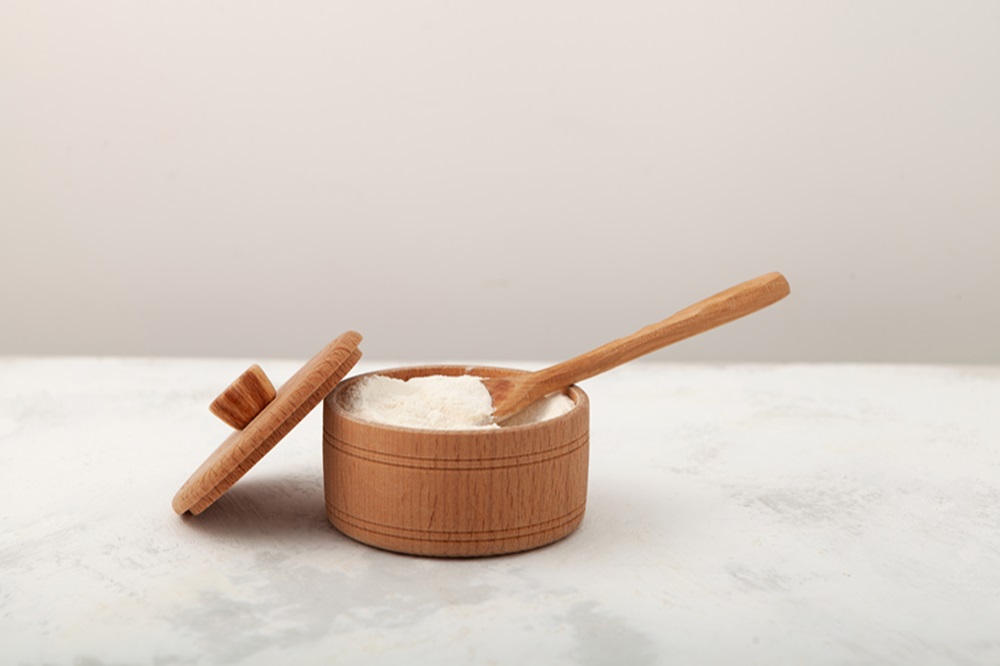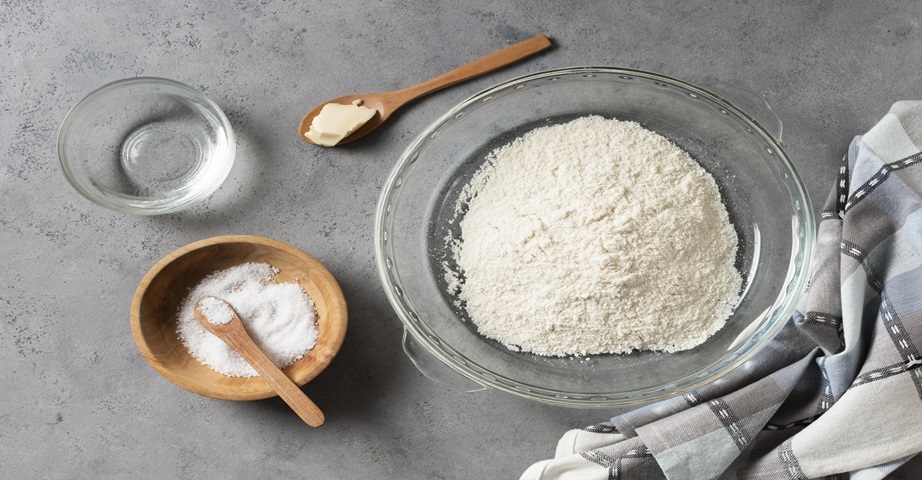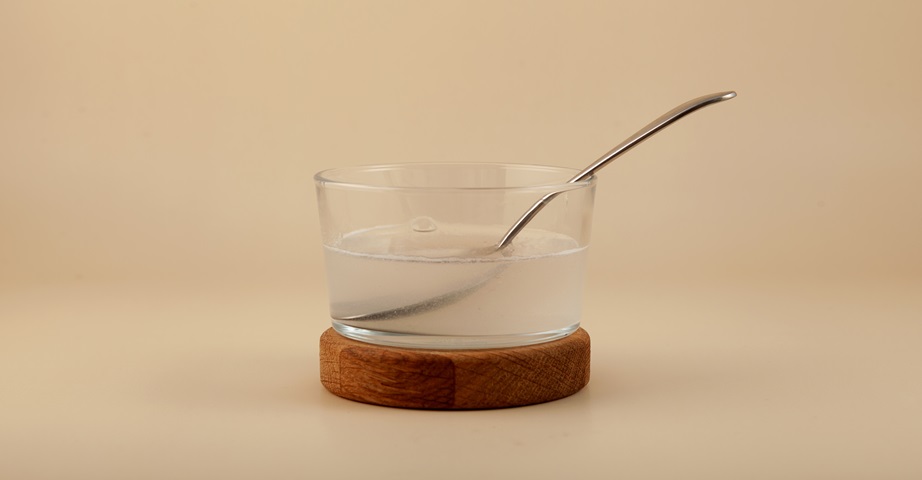Xanthan gum - a natural polysaccharide used as a food additive

Xanthan gum is one of the most popular food additives that has emulsifying, thickening and stabilizing properties. It is a substance of natural origin, used in commonly available food products - in sauces and dressings, as well as in ice cream, bread or biscuits. What is xanthan gum? How to use it? Is xanthan gum harmful?
Xanthan gum - what is it?
Xanthan gum is a natural substance of microbiological origin, often also called xanthan. It is a polysaccharide obtained as a result of fermentation of sugars, derived primarily from corn, and sometimes also from wheat or soy, which is made by the bacteria Xanthomonas campestris, naturally occurring on the leaves of cruciferous vegetables.
The xanthan gum is composed of glucose, mannose and glucuronic acid. It is a white powder that is formed by drying and grinding the substance produced by bacteria. The xanthan gum belongs to the group of hydrocolloids, which in water contribute to the formation of viscous coarse dispersion and the formation of gels. It is a substance that is highly soluble in both hot and cold water, which is used as a food additive called E415 .
Xanthan gum - use
The xanthan gum is used as a food additive that performs stabilizing, emulsifying and thickening functions. It is a substance that can play the role of a food stabilizer, among others in sauces and dressings, as well as in frozen and cooled dairy products. In addition, the xanthan has a positive effect on the creamy consistency of products and slows down the staling of bread, extending its use-by date. Moreover, the substance can increase the volume of the dough and its humidity, improving the consistency of the products, and can also provide stability when freezing and thawing food. The xanthan gum is also commonly used in gluten-free food, where it is a substitute for gluten, ensuring the desired density and structure of products. The substance is also used as a substitute for flour for thickening gluten-free dishes. In addition, the compound can be an alternative to beef gelatin, which can be especially valuable among vegetarians and vegans. The xanthan is also willingly used in dietary and high-protein foods and in products with reduced calories.
Interestingly, the xanthan gum can enhance the effects of other thickening substances, such as gum arabic, guar or konjac, which can positively affect the quality and palatability of food products.
However, the xanthan is widely used not only in the food industry, but also in other areas - the substance is used in the production of cosmetics, including bath lotions, shampoos, toothpastes or body lotions, as well as in the pharmaceutical industry during the manufacture of medicines in the form of tablets in which it plays the role of a binding substance and contributes to the gradual breakdown of the product and the prolonged release of valuable components contained in the tablet.
Recommended products
Guar gum or xanthan gum
The xanthan gum (E415), like guar gum (E412), is a natural polysaccharide. The properties and use of both compounds are similar, but the substances differ in origin - the guar gum is obtained from the endosperm of the seeds of the Cyamopsis tetragonolobus plant, and the xanthan gum is formed by the fermentation of sugars with the participation of Xanthomonas campestris bacteria. Moreover, the guar gum is more often used in cold liquids and dishes, and the xanthan gum - in warm products, however, both compounds are willingly used as a substitute for gluten in gluten-free dishes.
Xanthan gum - how to use?
The xanthan gum can be used for various types of dishes, and the amount of substance necessary to prepare a meal depends on the type of product being prepared.
When preparing brownie and muffins, about 1/4 teaspoon of the xanthan is usually added to a glass of flour. In turn, when kneading a shortbread dough, which should be slightly more flexible than a muffin cake, about half a teaspoon of the xanthan gum is used for a glass of flour.
Using the substance in food, it is worth mixing the solution with the xanthan with a mixer or blender at high speed. However, it should be remembered that mixing does not last longer than 60 seconds - longer mixing of the xanthan gum may have a negative impact on the taste of the dish.

Xanthan gum - recipes
The xanthan gum is an inconspicuous product that can definitely change the face of the daily menu, in particular during weight reduction. It is extremely important to know, how to use the xanthan correctly - too little of the substance may not give the desired effect, and too much can negatively affect the taste of the dish. Therefore, to make it easier for you to use the xanthan gum, below we have included some ideas and recipes for using the polysaccharide in your daily cooking.
Filling protein cocktail
Protein cocktail is a well-known product. With the addition of the xanthan, the snack becomes a filling dish with the consistency of foam mousse, which will provide you with a feeling of satiety for longer!
Ingredients: 200 ml of water, 30 g of protein supplement (e.g. OstroVit Wheylicious with a delicious chocolate-banana flavour), 1 g of xanthan gum, a pinch of salt.
Method of preparation: In the blender cup place all the ingredients and mix for 60 seconds at high speed.
Cheesecake on shortbread
High-protein cheesecake on shortbread dough with the addition of the xanthan gum is a delicious dessert that will perfectly fit into the diet of athletes. In the vegetarian version of the snack, a whey protein-based supplement is enough to replace the vegetarian alternative (e.g. OstroVit Vegan Protein Blend), while in the gluten-free version - instead of cake flour use an alternative in the form of gluten-free flour.
Ingredients: a glass of cake flour, 1/2 teaspoon of xanthan gum, 30 ml of cold water, half a cup of erythritol, 2 egg yolks, 50 g of butter, 100 g of natural skyr, 100 g of skimmed cottage cheese, 15 g of protein supplement (e.g.OstroVit 100% Whey Protein flavoured white chocolate), 1 egg.
Method of preparation: Mix xanthan gum at high speed with water. Add flour, erythritol, butter and egg yolks. Knead the dough, put on a baking mold and bake in an oven preheated to 180 degrees for 10 minutes. In the meantime, prepare the cheesecake mass - skyr, cottage cheese, protein supplement and egg put in a large bowl and mix to a smooth mass. Remove the baked pie crust from the oven, pour the cheesecake mass on the cake and put it in the oven again. Bake 30 minutes at 200 degrees.
Chocolate cookies with peanuts
Another sweet proposal that will be great as a snack for work, school or university. It is also a great solution for a small something for unannounced guests. You will prepare such cookies in a blink of an eye, and their taste will delight your loved ones.
Ingredients: 120 g of whole grain flour, 1 g of xanthan gum, 30 ml of water, 2 g of baking powder, 100 g of erythritol, 2 eggs, teaspoon of cocoa, 50 g of butter, 50 g of peanuts, a pinch of salt.
Method of preparation: Mix xanthan gum at high speed with water. Add flour, baking powder, salt and cocoa. In a separate dish, grate the butter with erythrol, then add the eggs and mix until smooth mass. Gradually add the dry ingredients to the wet and mix until they are combined. Add peanuts to the mass and mix again. Place portions the size of a walnut with a spoon on a baking sheet lined with paper. Bake at 180 degrees for about 15 minutes.
Wholegrain rolls
The xanthan gum is a perfect solution for athletes and lovers of sweets, but the xanthan is also great for everyday bread baking. Time for a recipe for wholegrain, crunchy rolls with the xanthan gum!
Ingredients: 400 g of whole grain flour, 100 g of wheat flour, 200 ml of milk, 100 ml of water, 20 g of yeast, 10 g of sugar, a teaspoon of salt, 4 g of xanthan gum, a handful of flaxseed, two tablespoons of pumpkin seeds, two tablespoons of sunflower seeds, three tablespoons of rapeseed oil.
Method of preparation: Heat the milk in a pot, add crushed yeast and sugar. Cover and leave to rise. Mix the flours with the seeds and the xanthan gum with water at high speed. Add the grown yeast to the flour mixture and mix. Also add water with xanthan gum and a pinch of salt, and knead the dough with your hand, gradually adding rapeseed oil as well. Cover the dough and leave it to rise for an hour. Cake for rolls manually knead and divide into several equal parts. Form each piece of dough into a ball in your hands and place on a baking tray lined with baking paper. Sprinkle the finished products with seeds on top and place in an oven preheated to 200 degrees. Bake for about 20 minutes.

Xanthan gum - harmfulness. Is it healthy?
Although the name of the compound sounds a bit mysterious, and the abbreviation E415 used in food sometimes raises concerns and doubts, the xanthan gum is considered a safe and healthy compound, which is referred to as the best natural thickener. The xanthan in the human digestive system behaves similarly to water-soluble dietary fibre - it puffs up in the stomach, increases the feeling of satiety and is not digested in the gastrointestinal tract, although it can be partially broken down by the bacterial flora present in the intestines into short-chain fatty acids.
The xanthan gum consumed in moderation does not contribute to the occurrence of undesirable ailments, and according to the results of research, it also does not have a toxic effect on the human body. However, the substance should not be used by people who are allergic to the product from which the xanthan was obtained, i.e. corn, wheat or soy. What is more, when using the polysaccharide, you should be moderate - excessive supply of the ingredient in your daily diet can contribute to the occurrence of side effects and may result in digestive system ailments, such as abdominal pain, nausea, bloating or diarrhea.

